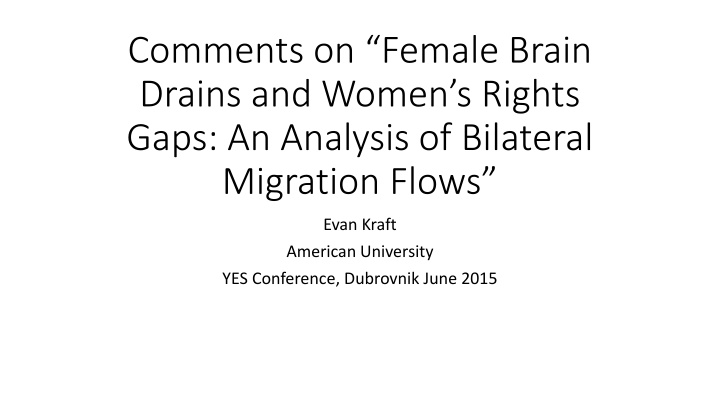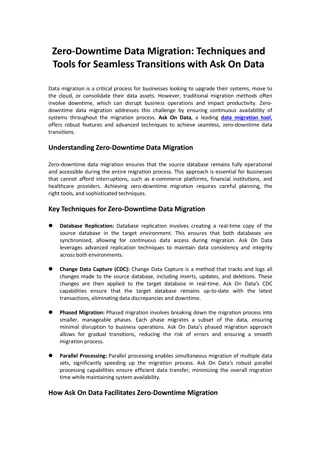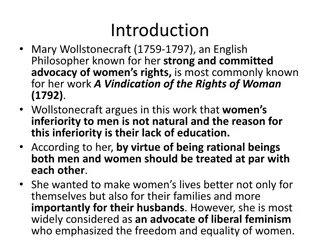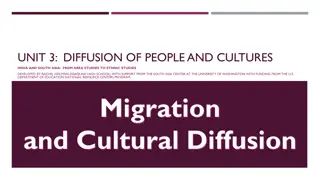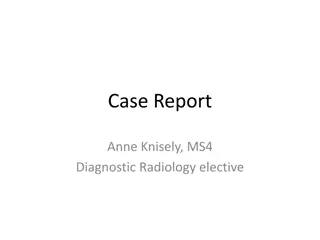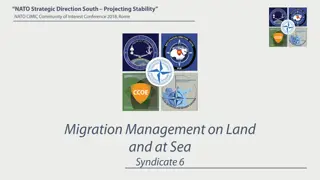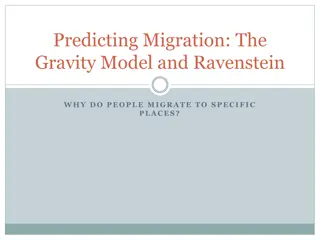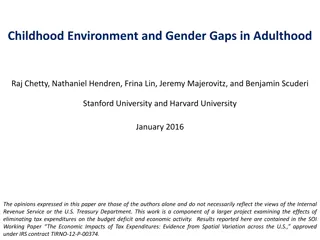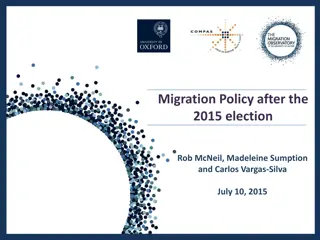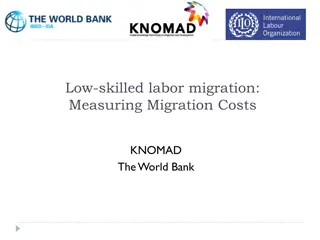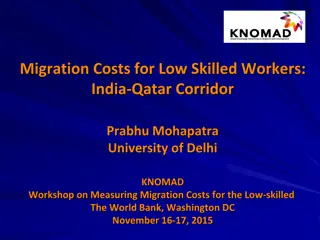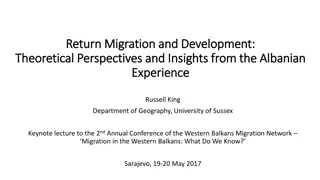Analysis of Female Brain Drains & Women's Rights Gaps in Bilateral Migration Flows
Observations show women migrate more than men, affected by factors like family reunification. Skilled women migrate more than skilled men, contributing to brain drain. Research examines impact of women's rights gap on female brain drain ratio using a non-linear model, indicating a complex relationship. Motivation for non-linearity stems from decreased discrimination leading to increased opportunities for women to migrate. A technical problem of multilateral resistance in migration is also discussed.
Download Presentation

Please find below an Image/Link to download the presentation.
The content on the website is provided AS IS for your information and personal use only. It may not be sold, licensed, or shared on other websites without obtaining consent from the author.If you encounter any issues during the download, it is possible that the publisher has removed the file from their server.
You are allowed to download the files provided on this website for personal or commercial use, subject to the condition that they are used lawfully. All files are the property of their respective owners.
The content on the website is provided AS IS for your information and personal use only. It may not be sold, licensed, or shared on other websites without obtaining consent from the author.
E N D
Presentation Transcript
Comments on Female Brain Drains and Women s Rights Gaps: An Analysis of Bilateral Migration Flows Evan Kraft American University YES Conference, Dubrovnik June 2015
Some notes from the literature Women are observed to migrate more frequently than men Network effects here dependence of migration flows on the stock of migrants in the receiving country are more important for unskilled workers than skilled Argue that women are more likely to emigrate for family reunification reasons Find that skilled women migrate more frequently than skilled men greater brain drains of women Beine and Salomone (2013) argue that the most salient differences in migration behavior are due to differences in education, not gender
Contribution of the paper Ask about the effects of the relative state of women s rights in origin and destination country on the female brain drain ratio, defined as the ratio of flows of female migrants to male migrants of a given education level (flows/population with education and gender characteristics) Uses model derived from gravity-model based migration literature Instead of common sense notion that migration is proportional to the gap in bilateral women s rights, propose a non-linear model Use enormous data set, multiple aspects of women s rights, they find support for a non-linear relationship between the women s rights gap and the female brain drain ratio
Motivating the non-linearity Argue for a non-linear net benefit due to convex, increasing costs coupled with increasing benefits One way to think of it: if discrimination decreases in the sending country, women may gain more freedom to leave and migrate more. Here the emphasis is on decreased interference by others (mainly mainly male family members, one would suppose). This view is relaxation of resistance. Another way to think of it: if discrimination decreases, women have more economic opportunities, and gain skills or resources that then allow them to migrate. Example: they get schooling or training that then allows them to successfully apply to colleges abroad. This view is increased opportunity.
Technical problem: multilateral resistance Immigation from origin country I to receiving country j may depend on what happens in country k Trivial example: if Italy decides to rescue migrants and grant them permanent status, they may later move on to other countries Bertoli and Fernandez-Huertas Moraga (2012 and 2013) incorporate this problem into their models by using Pesaran s Common Correlated Effects Estimator to allow for common unobserved variables in groups of countries referred to as nests Adopted in this paper
Technical problem: dealing with lots of zeros With bilateral migration data, many yearly flows turn out to be 0 Gravity metaphor breaks down: while gravity cannot ever be 0, migration can. We cannot be sure whether the flows really were 0 or they were so small as to unobserved or rounded down Question in the literature: is this to be seen as selection bias (unseen factors cause migration to be 0 in a non- random selection of countries)? Or is it measurement error (rounding down) This paper uses Heckman 2-step correction to account for selection bias In this setup, the zeros are an extra headache because the Female Brain Drain Ratio becomes undefined.
Another possibility for dealing with the zeros: a two-equation system First, a threshold model to predict whether bilateral migration happens at all Then a standard gravity model An analogous model is developed in Hallak (2006), where there is a cost threshold above which there are no imports. A two-equation system is estimated, even though the threshold is unobservable This works well for Hallak, because theory suggests a relationship for the threshold. Not clear how to implement this in the migration context, but might be worth exploring.
Another alternative estimator: FGLS Following Silva and Tenreyro (2006), this paper uses the Poisson pseudo-maximum likelihood estimator (PPML) to handle the many zeros and undefined values of the FBR. Martinez-Zarzoso (2013) compares the PPML method used here with Feasible Generalized Least Squares This is motivated by the finding that PPML is not unbiased It turns out the FGLS sometimes outperforms PPML, and sometimes it is the other way around It would be useful to either test for this or argue why it is not important
